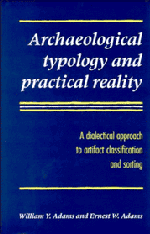 Archaeological Typology and Practical Reality
Archaeological Typology and Practical Reality Book contents
- Frontmatter
- Contents
- List of figures
- List of tables
- The archaeologist's preface
- The philosopher's preface
- PART I Introductory
- PART II The nature of types and typologies
- PART III Typology in action: the Medieval Nubian Pottery Typology
- PART IV Pragmatics of archaeological typology
- 13 The starting point: purpose
- 14 The determinants of types: variables and attributes
- 15 The making of types: formulation, designation and description
- 16 The use of types: typing and sorting
- 17 The ordering of types: taxonomy and seriation
- 18 Variation and variability in archaeological classifications
- 19 The bottom line: practicality
- 20 Principles of practical typology
- 21 Information-theoretic formulations
- PART V Classification, explanation, and theory
- Appendices
- References
- Index
20 - Principles of practical typology
Published online by Cambridge University Press: 23 November 2009
- Frontmatter
- Contents
- List of figures
- List of tables
- The archaeologist's preface
- The philosopher's preface
- PART I Introductory
- PART II The nature of types and typologies
- PART III Typology in action: the Medieval Nubian Pottery Typology
- PART IV Pragmatics of archaeological typology
- 13 The starting point: purpose
- 14 The determinants of types: variables and attributes
- 15 The making of types: formulation, designation and description
- 16 The use of types: typing and sorting
- 17 The ordering of types: taxonomy and seriation
- 18 Variation and variability in archaeological classifications
- 19 The bottom line: practicality
- 20 Principles of practical typology
- 21 Information-theoretic formulations
- PART V Classification, explanation, and theory
- Appendices
- References
- Index
Summary
Before concluding the practical section of our work, it seems desirable to synthesize the main ideas that have been expressed in earlier chapters into a set of general principles, which we will call “principles of practical typology.” For convenience they will be subdivided into basic principles, principles of type formulation, principles of practicality, and principles of utility.
Basic principles
A type, as defined in this work, is at once a group of entities, our ideas about those entities, and the words and/or pictures in which we represent our ideas. In other words a type in the fullest sense has material, mental, and representational dimensions (Chapter 3).
The relationship between the material, mental, and representational dimensions of typehood is mutable. Either the objects, our ideas about them, or the ways in which we represent the ideas may change, without necessarily effecting change in the other dimensions (Chapter 3).
Types have the two essential properties of identity and meaning. That is, to be useful they have to be consistently identifiable, and they have in addition to tell us something that we want to know (Chapter 3).
Individual type concepts can originate in various ways, by intuition or by some process of conscious analysis. Once they have come into being, type concepts generally evolve as we apply them to actual entities, through a continuous feedback between our observations of the objects and our ideas about them.
- Type
- Chapter
- Information
- Archaeological Typology and Practical RealityA Dialectical Approach to Artifact Classification and Sorting, pp. 239 - 243Publisher: Cambridge University PressPrint publication year: 1991


